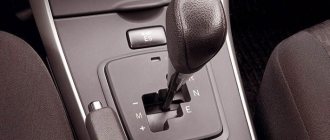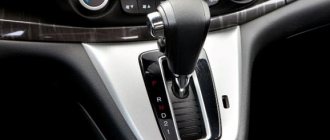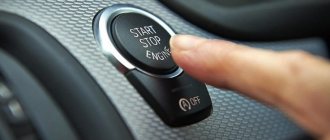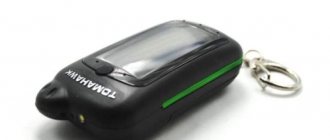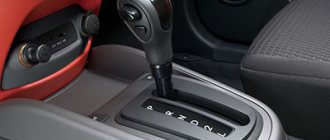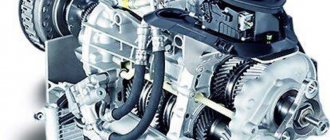The first generation automatic transmissions, which did not yet have manual speed control, used a special design with reduction gears. Many drivers simply do not understand why downshifts are needed on an automatic transmission and how to use such a gearbox correctly. Let's take a closer look at what downshifts are used for on an automatic transmission.
Additional modes
"N"
This is the normal operating mode of the automatic transmission without the use of “special effects”.
"E"
The so-called “economical” mode of operation of the automatic transmission. Used to ensure smooth, calm, measured movement of the machine. It is used in cases where you want to significantly reduce fuel consumption and the amount of harmful emissions.
"S"
Sport mode is the exact opposite of “economy” mode. Automation allows the box to use engine power to its fullest. There can be no talk of any fuel economy in sport mode. The car becomes more “dirty” and “gluttonous”, but the acceleration becomes really sharp.
"OD"
"Upshift" or "overdrive" function. As a rule, overdrive is activated by a separate button on the automatic transmission lever. The transition (or exit) to this mode is indicated by a separate symbol on the dashboard. Essentially, this is engaging the extreme fourth or extreme fifth gear in the box. You can switch to “overdrive” only at speeds of 75-110 km/h. Moreover, this mode should be exited at speeds below 70 km/h. The main advantage of “overdrive” is the increase in vehicle dynamics and fuel economy at high speeds.
"W"
Winter mode. Found in some automatic transmissions. Sometimes indicated by a snowflake. Used exclusively when starting on a slippery surface. When switching to this mode, the transmission will start immediately from second or third gear.
What do the letters on the automatic transmission mean?
When the time comes to learn to drive, many students are faced with the question of which automatic transmission to learn to drive. There is an automatic transmission and a manual transmission. So what are these letters? Automatic transmission - what it is is not entirely clear. This is nothing more than the ability to drive a car in automatic mode. The driver can only learn to decipher the symbols on the automatic transmission, which are located on the panel near the mode switch lever. Today we will look in detail at what the letters on the automatic transmission box mean.
How to use automatic transmission correctly
An article about how to use an automatic transmission correctly - symbols on the automatic transmission panel, starting the engine, moving and stopping, possible errors. At the end of the article there is a video about using an automatic transmission. An article about how to use an automatic transmission correctly - symbols on the automatic transmission panel, starting the engine, moving and stopping, possible errors. At the end of the article there is a video about using an automatic transmission.
Today, according to statistics, most cars are produced with an automatic transmission. Technically, this means that the car has a transmission in which the gears are changed electronically.
At the moment, there are three types of automatic transmissions: “classic”, with “continuously variable transmission”, and with “robotic mechanics”.
Depending on the modification and manufacturer, these types of transmissions may differ slightly (different number of gears, slightly different lever stroke - straight or zigzag, designations, etc.), but the main functions will be the same for all.
The growing popularity of automatic transmission is understandable - it is more convenient to use (than manual transmission), especially for beginners, it is reliable and protects the engine from overloads.
It seems that everything is simple! However, drivers still make mistakes, and even the most reliable mechanism can fail if it is not used correctly. Next, we will look at how to use the automatic transmission correctly and how to operate it correctly.
Mode "S" on an automatic transmission: what you need to know
The active development of the automotive industry continues today thanks to the introduction of the latest technologies in this industry. In modern cars, the manufacturer invests a large margin in terms of dynamic and power characteristics, improves the level of equipment, safety, etc.
Note that, given the great popularity of automatic transmissions, the “S” (Sport) mode is designed to fully experience the “drive” of driving a car. Also, this mode can help the driver in a difficult situation. In this article we will look at what “S” gear is on an automatic transmission, why this mode is needed and how to use it.
A short note on how to start driving with an automatic transmission
- Put the lever in position P or parking
- Turn the key in the ignition and start the car engine
- Squeeze the brake and, holding it pressed, set the lever to position D drive.
- Gently release the brake and add gas and start moving.
- Remember that when changing any position of the speed lever you must depress the brake pedal
- Also, on the automatic transmission, it is highly not recommended to tow anyone or pull a trailer - you are overloading this automatic transmission, which will lead to its rapid wear or even failure immediately at the time of towing
- With an automatic transmission, towing a stalled car is carried out in the N neutral lever mode, and the towing itself can be done at a distance of no more than 50 km at a speed of no higher than 30 km.
If you have a question about what is better, automatic or manual, then read here, and our article entitled - automatic transmission, the meaning of letters and numbers has come to an end, here we looked at the most common designations on automatic transmissions of cars, if you have anything to add or ask fellow motorists, reflect this in the comments under this article.
We also recommend watching a video of what the letters on the automatic transmission box mean.
Lock as a precaution when driving an automatic car
Driving an automatic for beginners requires careful attention to the vehicle's driving modes. Thus, you should remember a few simple rules:
The automatic transmission lever is designed with some safety measures
If the automatic transmission lever switches to certain modes without pressing the lock button, this means that the lever can be moved into these ranges both when the car is moving and when starting off. If the lever is moved to a certain mode only by pressing a button on the selector, then this indicates that some precautions must be taken to perform this action. Thus, with the selected driving mode “1”, it is possible to safely move the lever to position “2”, and then switch it to range “3” or “D” on the move, without stopping your vehicle
However, it is worth noting that switching the lever from the “Third” position to the “Second” or “First” is already accompanied by pressing the latch. This is done to prevent damage to the box if the driving mode is incorrectly selected. Otherwise, the machine will be subjected to significant overloads, which will inevitably lead to its breakdown.
Thus, with the selected driving mode “1”, you can safely move the lever to position “2”, and then switch it to the “3” or “D” range on the move, without stopping your vehicle. However, it is worth noting that switching the lever from the “Third” position to the “Second” or “First” is already accompanied by pressing the latch. This is done to prevent damage to the box if the driving mode is incorrectly selected. Otherwise, the machine will be subjected to significant overloads, which will inevitably lead to its breakdown.
Therefore, to correctly switch between modes in this order, it is necessary to either stop completely or slow down the speed of the vehicle. Thus, switching the lever from position “Two” to “Third” gear without using a locking button is impossible; compliance with restrictions is required. Namely, you cannot use such a combination when driving above a speed of 70 km/h, so as not to damage the transmission. Although in new automatic transmission models this nuance seems to have been removed, so switching when driving even at high speeds will not bring much harm, even if the switch is incorrect.
That's all we wanted to say on this issue. Driving an automatic transmission for novice drivers causes difficulties only at first, which cannot be said about a manual transmission. First you need to understand the modes of your transmission. In any case, all the necessary recommendations for using the automatic transmission capabilities of a specific car model are available in the service documentation. Such documents usually “come” with the car upon purchase, or can be found by make and body number on the Internet.
"Manual automatic transmission mode"
Finally, on automatic transmissions there is also a gear designation with the letter “M” . If there is one, then this is most likely the “manual” mode or simply “manual mode”. Essentially, this option allows you to emulate the operation of a manual transmission on an automatic transmission. In this case, increasing and decreasing gears is carried out using the lever through the symbols “+” and “-”. Boxes with this mode have special protection.
The use of M-ki is relevant in cases where you need to drive on severe off-road conditions in a low gear and avoid slipping. This mode is good when cornering and performing a number of other maneuvers, including sharp overtaking. Finally, the “M” mode can be used when coasting down a hill (during engine braking).
Many motorists are tormented by the question of how to properly drive a car so that it lasts for many years ? There's really nothing complicated about it.

